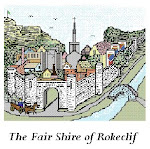Rokeclif, Northshield, December 2009
Whether you fight, craft or dabble in the bardic arts, each of us is on a path of learning.
SCAdians are folks who never want to stop discovering and know that life itself is a classroom. For a day, some of us literally went back into classrooms to further our knowledge. Stellar University of Northshield, SUN, offered twelve class tracts ranging from marital studies and meat pies to heraldry and history. Seven hours of classes within each category made for a dizzying 84 options and a very full day.
Some seek to brush up on old learning, some to dabble in things they know nothing of. For my
own part, I sought out classes near to my heart; heraldry, literature and history. I’ve taken a few classes concerning British and period literature as well as done a fair bit of reading on my own. Only at SUN, however, would four Lords known for their fighting prowess discuss chivalric literature. Such uniquely SCAdian perspectives were exactly what I hopped to take advantage of at SUN.
When we enter into the SCA, should we choose to make it more than a casual contact, we find a
culture and history so rich and full that it stands its own alongside mundane modern history. Two classes I chose where just to learn more about being a SCAdian of Northshield. The one I’ll never forget was a presentation of “Row Men Row” by a certain bard called Owen Alun. Through the song’s eighteen verses he gave those listening a glimpse into each reign during the Northshield principality with all due explanations for those entering green like myself. The passion he felt for the SCA, and his kingdom in particular, came through and touched everyone present. The teachings of our bards unite us in pride as well as knowledge. When I was later informed that this gentle is known as ‘The Owen’ I knew for myself just why.
After doubling my knowledge of Northshield inside a day, what better way for SUN to end than
with court presided over by our King Siegfried? He and his Queen held court and saw to many fine acts. The transference of the Baronage of Jararvellir, the appointing of vigils for a newly nominated Laurel and Pelican, and the granting of many honors to both friends and strangers made this the most enlightening and enjoyable court I’ve yet had the privilege to attend.
I went to SUN with high expectations for both fun and learning. I’m grateful to write and say
this event did not disappoint. I would urge every SCAdian to at least once take such an opportunity when it comes around.

